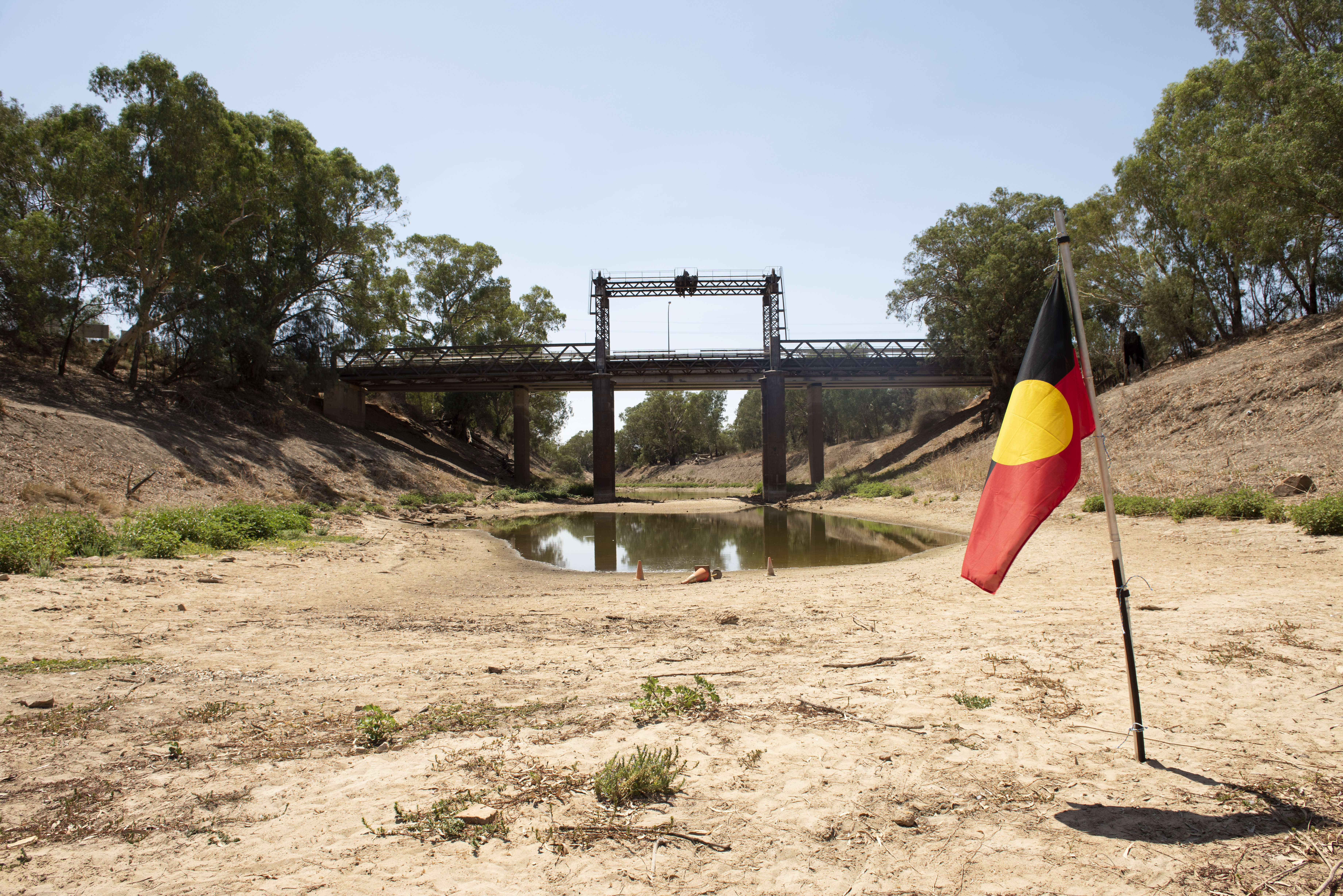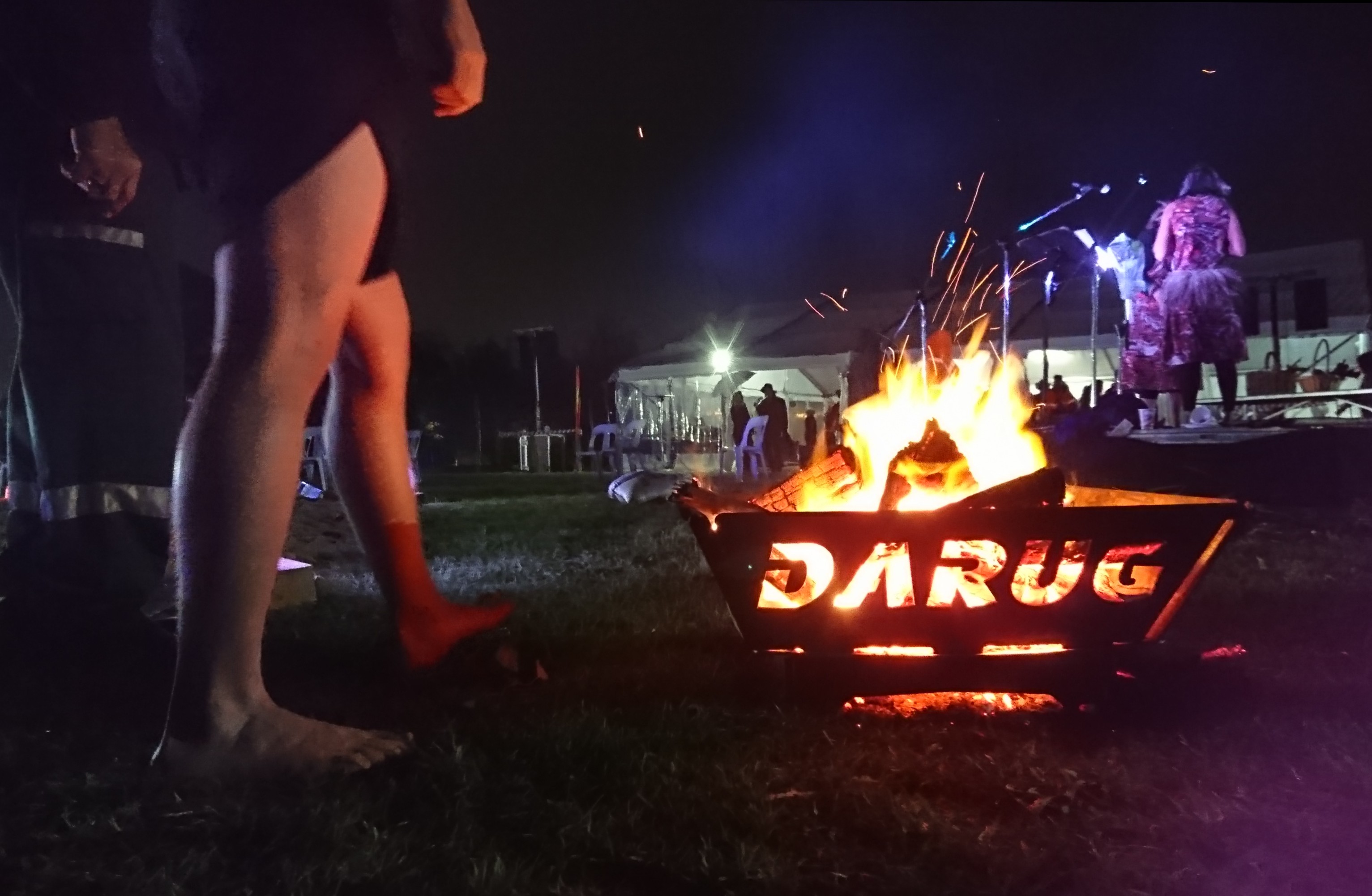
An Aboriginal flag planted on the dry riverbed of the Darling River at Wilcannia, 2019,photo by John Janson-Moore
The worst drought in Australia’s history brought our largest river system to the brink of collapse. Millions of fish died and the towns that rely on its low-quality water supply — many with Aboriginal communities in the majority — were devastated.
On the New South Wales south coast, bushfires ravaged vast landscapes and townships. People lost their loved ones and livelihood.
Scenes of fear-struck residents seeking refuge on the land’s edge made for distressing viewing from hundreds of kilometres away. In the city our bodies felt slow and heavy under months of smoke-filled skies and on the beaches ash particles blackened the water’s edge and charred tree trunks bumped their way to shore.
The fire’s aftermath continued to reveal itself: the dead carcasses of kangaroos and wallabies strung up on the wire fences they would normally so deftly navigate, their burnt bodies littering bitumen roads, and koalas the forest floors.
Over that summer, I kept coming back to earlier events on the Gomeroi grasslands country of north western New South Wales. The ‘killing times’ in the mid 1800s saw widespread massacres of Gomeroi people. In the 1838 Myall Creek massacre, bodies were piled together and burnt to conceal the crime. Earlier that same year, at Slaughterhouse Creek on the Gwydir river, 15 armed stockmen launched a dawn attack on a sleeping Aboriginal clan. They killed about 300 men, women and children. When I watched those news stories about the fires, my mind flicked between the images of dead kangaroos and koalas and my relations of some five or six generations back.
I wasn’t alone in feeling the present haunted by the past. The drought and bushfires sparked conversations about how we approach land management and what we can learn from the many thousands of years of occupation before intensive industry and extraction rendered such destruction.
While Indigenous fire management has captured the public imagination, perhaps something more transformative is needed. Here I gather examples of the impact the climate crisis is having on Aboriginal lives, and some innovative responses.
In mid 2019, I visited the far western New South Wales town of Wilcannia on the Darling River. First colonised by merino and once known as the ‘Queen of the desert’, it was a boom town for a few generations of settlers. The local Keewong mob talk about ‘before sheep’ and ‘after sheep’. But those images of jostling paddle steamers laden with wool bales heading for South Australia and the global market contrasted starkly with the bone dry, withering cavern before me.
For Barkandji people the river, or barka, is mother. This river, the equivalent of several stories deep, has supported their people for thousands of generations, the last five or so alongside Europeans. But no longer. Everything is dead. Freshwater mussels the size of your outstretched hand have withered in their shell, weeds cover parts of the riverbed, and fragments of glass from the colonial heyday flash under the belting sun.
At the top end of the river system, Aboriginal communities despair at the state of the river and its impact on their health, recreation and future on their country. The drought and climate change are part of colonisation’s ongoing threat to their survival on country.
In 2018 and 2019 Barkandji people held three rallies that briefly blocked the Barrier Highway that travels through Wilcannia to Adelaide. By mid-2019 they were despairing as they watched the water getting lower and lower. But their campaign and concern for the river goes back decades (if not to 1850).
The mass fish kills in late January 2019 downstream at Menindee Lakes had brought the horror to a national audience. Seeing cod fish, the ‘old men of the river’, cradled in the arms of grieving farmers reverberated with a concerned public. For Barkandji people this underscored their powerlessness in the debate over their river.

Darug handover ceremony of Blacktown Native Institute site, 2018, photo by Jennifer Newman
Barkandji man and Wilcannia Local Aboriginal Land Council member Kevin Cattermole explains the effect of the barka’s health on Aboriginal lives: ‘everybody’s got nowhere to go, they’ve got nothing to do … now it’s just dead. It’s lifeless.’
Michael Kennedy, Chair of Wilcannia LALC, also details the non-human impact: ‘everything’s dying with it … The fish, the mussels the yabbies; the bird life isn’t here anymore like it used to be. You hear a few birds chirping now but that’s nothing compared to what it used to be.’
Beyond the physical devastation is the impact on Aboriginal stories of place, Cattermole says: ‘It’ll die out. It’ll die. There will be no stories for the kids. All they’ll be hearing is how the white people destroyed our culture, our way of life, our self-being. There will be nothing for them. They won’t be able to pass stories on because they won’t have nothing to tell about the river. What are we gonna leave our kids? They’re not gonna see what we saw.’
Barkindji elder Badger Bates, a leading spokesperson for the barka, also raised concern for the future of his people. During an interview he pointed to his niece in the audience and shared his fear at the loss of her totem, the bony bream. It was the end of generations of swimming, jumping from the bridge, kids cooeeeing, and a regular diet of hand caught cod and yella-belly at the weir. Rain has brought some respite, but for how long is uncertain.
Their survival on country, and all of our survival on this ancient land, calls for a radical reconceptualisation of country and how we manage its resources.
Potawatomi man Kyle Whyte, a professor of philosophy at Michigan State University, argues that Indigenous peoples are confronting climate change having already passed through environmental and climate crises induced by colonial violence. He describes the productive dialogue between descendants and ancestors as they walk alongside each other in the present.
Across New South Wales are endless examples of connection and reconnection by Aboriginal people and their communities across past and present generations. The idea finds some resonance in Noel Pearson’s ‘Declaration for Australia’, where he joins the ‘three stories that make Australia’: the ancient Indigenous heritage which is its foundation, the British institutions built upon it, and the ‘adorning gift’ of multicultural migration. It also finds expression in the Uluru Statement from the Heart’s call for all Australians to ‘walk with us’.
An example can be seen in the recent ‘handover’ of the Blacktown Native Institute site negotiated by the Darug people of western Sydney. On Richmond Road in Blacktown the Native Institute or ‘Institution’ operated as a school for Aboriginal children from 1823 to 1833. For many years the site languished behind a cyclone fence without signage, until almost 200 years later when descendants of the schoolchildren identifying as Darug held a tremendous ceremony to celebrate its return. The handover of the site has allowed them to walk in their ancestors’ footsteps and restore dignity to their world.

Understaning Kinship, Country, Lore and Dreaming. Image courtesy Environment NSW

Yunghadu ceremony, photo by Mal Ridges

Yunghadu (malleefowl), photo by Craig Allen
A similar process has been underway in the south western corner of New South Wales, where traditional owners and scientists have collaborated in an effort to bring back the yunghadu or malleefowl. This approach to species regeneration and habitat restoration saw traditional owners host visitors to country to celebrate the yunghadu with an overnight dance and song reminiscent of a corroboree ceremony. The aim is to forge a close relationship with and respect for the yunghadu’s country to create an environment for the bird to return.
Murrawarri man Fred Hooper made a similar argument in relation to his country, which covers north western New South Wales and south west Queensland. He led research to support the adoption of ‘cultural flows’ as a water allocation priority in the Murray-Darling river system as a means of restoring the Murrawarri society and economy on the upper Darling and its spiritual, cultural, environmental values.
The local Gooraman swamp — a significant creation site highlighted in Hooper’s research — needs water not just to support thousands of birds, but also for the mundaguddah, or rainbow serpent, that journeys across Murrawarri land linking a series of waterholes. Extreme droughts and water extraction have risked connections between landscapes and the ability to talk to ancestors.
Continuing the spirit in which Aboriginal people approached the climate crisis for many years, I suggest the gifting to all Australian children, subject to local Aboriginal protocol and decisions, of a ‘totem’ at birth. Such a gift might serve to deepen connection to country and transform relations with environment and our ancient past and present. The giving of totems — like the now familiar practice of welcome to or acknowledgement of country, which adapts the longstanding practice of seeking permission to move into another’s country — could help children maintain a sense of their place in relation to one another and to the animal and plant world and with the deep past.
If the totem of the bony bream highlights its loss as a risk to the lives of all river people, might other totems also inspire us to smell, taste and feel country, to know the pleasure of being in country, and to take responsibility for country in the past and present?
Professor Heidi Norman is a Gomeroi woman and a leading researcher in Australian Aboriginal political history at the University of Technology Sydney.


